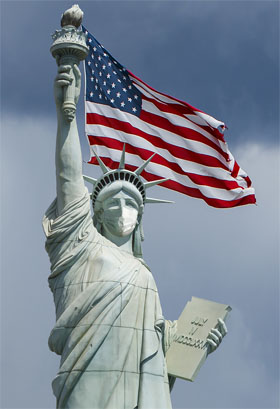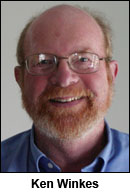OPINION
Inequality pandemic deadlier than COVID
The virus has brought into focus much about our country that was already weak, broken and just plain wrong.
By KEN WINKES
(May 28, 2020) — COVID-19 has punched the nation’s pause button, and though the president is eager to get things back to “normal” before the November election becomes a plebiscite on his handling of the pandemic crisis, it’s uncertain how soon we will be up and running again.
 With more than 100,000 COVID-19 deaths and 34 million workers unemployed, with no clear direction from Washington, D. C. beyond an executive order to reopen meatpacking plants without adequate testing, and with each state variously attempting to balance public safety and economic recovery, it will be a long time before our future becomes clear.
With more than 100,000 COVID-19 deaths and 34 million workers unemployed, with no clear direction from Washington, D. C. beyond an executive order to reopen meatpacking plants without adequate testing, and with each state variously attempting to balance public safety and economic recovery, it will be a long time before our future becomes clear.
Will it look the same as it did? Will we go back to the same old movie, picking up exactly where we left it in March?
I certainly hope not.
For while the shape of our future is unclear, the virus has brought into focus much about our country that was already weak, broken and just plain wrong.
We are learning which parts of our economy are “essential” and which are not. And we are at long last acknowledging how many of those essential goods and services are provided by workers drawn from the lower end of our economic ladder.
Health care, so obviously critical in COVID-land, provides a prominent example. There are more than 1.5 million nursing assistants working in the medical field, their salaries averaging less than $30,000 a year. In addition, nearly 3 million health care and personal aides worked in our homes in 2018. Their median pay was a paltry $11.12 per hour.
The same pattern of absolutely essential but undervalued workers holds true for millions of retail clerks, warehouse, farm, and food-processing workers, all workers we cannot live without. Now they are being asked — some, required — to risk their lives and the lives of their families on the nation’s behalf.
That these workers, most unprotected by union membership, lacking health insurance and working long hours for little pay, are suddenly in the headlines constitutes this pandemic’s unmistakable lesson: Over the last fifty years a consuming cancer of inequality has lodged in our economic bones, fraying our social fabric, dividing us into a nation of haves and have-nots.
We live in a nation where the top 1 percent possess as much wealth as the bottom 40 percent. Another way of expressing this same gut-wrenching division: As of Sept. 30, 2019, the bottom 50 percent of households had $1.67 trillion or 1.6 percent of the nation’s net worth, while the top 10 percent held $74.5 trillion or 70 percent.
With COVID-19’s arrival, that division is no longer just a set of numbers. It’s literally deadly, pointing directly at that part of our working population where COVID-19 is most likely to find its victims: in our vulnerable yet essential workers.
Yet recent economic rescue efforts have tipped the economic balance even more in wealth’s direction. The Federal Reserve has guaranteed billions of dollars of corporate bonds, propping up the stock market by insulating private equity junk bond holders from their bad decisions.
Large corporations took one quarter of the first $2 trillion package and smaller businesses got little. Caterpillar took the grants and loans but nonetheless announced plans to lay off thousands of their workers while granting a $500 million dividend to its stockholders. Other large companies followed suit.
It’s no surprise, really. We know wealth serves wealth, but we’re still expected to believe that a stock market in which barely half of the nation is invested is a sensible measure of our economy’s health.
Phooey!

If our economy really served the people, we would have a healthcare system that works for everyone, not for insurance companies. We would have fixed our failing infrastructure instead of just talking about it. Our college students would not be trillions of dollars in debt. We would have a progressive tax system that placed the burden on those who could afford to pay. Workers would be at the table when trade agreements are hammered out, and labor unions would be encouraged, not under constant attack.
Instead, we are kept from meeting the obvious needs of the majority by the immense gravitational pull of too much money in too few hands.
In some respects, we’re even going backwards. Three million have lost health insurance since 2016, and since their health insurance was tied to lost jobs, an estimated 27 million are now left hanging out, flapping in the COVID-19 breeze.
The rational healthcare, infrastructure and education funding we don’t have and corporate-friendly trade agreements we do are both symptom and cause of the inequality which poisons our politics.
Instead of blaming the system, we blame one another (even mask-wearing has become an ironic symbol of our political divisions), dissipating our energy in the anger and despondency that blind us to the real cause of the mess we’re in.
As lethal as it is, COVID-19 is not the gravest threat we face. The inequality pandemic that afflicts our nation is far deadlier to ourselves and to our democracy.
In 1992, James Carville, Bill Clinton’s political advisor, famously said, “It’s the economy, stupid.” He had the right words but in the wrong order. If we didn’t know it before, COVID-19 has taught us that. An effective cure for any disease must begin with a sound diagnosis.
It is our stupid economy that is making us sick.
 Ken Winkes is a retired teacher and high school principal.
Ken Winkes is a retired teacher and high school principal.





